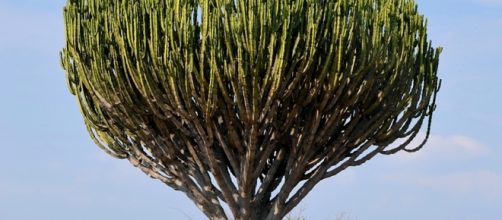Africa has an abundance of lovely trees and there is nothing quite as pleasant as sitting under the shady canopy in the heat of the day. Campers in Africa will always try to find a nice shady tree under which to pitch their tent. In other European countries campers seldom camp under a tree. The reasons for this are logical.
- Trees attract lightning
- Trees can blow over or fall down.
- Campers in cooler climates don’t need the shade to keep cool
Visitors to Africa are exposed to the dangers of lighting and trees or branches falling, but most often the real need for a cool shady area during the heat of the day leads to tents being pitched under trees.
Not all trees are friendly in Africa. There are some that need to be avoided because of their poisonous properties, and others that can simply make your life miserable.
1.Spirostachys africana, also known as the Tamboti tree.
The Tamboti is a widespread tree which is found along South Africa’s east coast, across the Kruger Park area, and into Zimbabwe. It is usually found in low-lying bush near rivers or streams. The tree grows to 10m in height.The leaves are very small. The bark is rough and grayand forms chunky flakes.
The Tamboti has milky latex which is very poisonous. Plucking at leaves can cause burning and if it gets in the eyes can temporarily blind humans and livestock. Permanent eye damage has been known to occur.
Placing the wood on a fire will cause nausea and headaches. Even handling the wood can cause irritation to sensitive skin.
2Euphorbia Ingens, also known as the Candelabra tree.
Candelabra are found in Zimbabwe and South Africa and are most often seen near rocky outcrops or growing among large termite mounds. It is a many-branched tree with a spiky look to the fleshy leaves.
Candelabra have milky latex which is very irritating to skin and eyes. Latex can cause permanent blindness, and is capable of burning the skin.Swallowing the latex will cause severe vomiting, abdominal pain, and diarrhea.
3.KigelIa africana, or Sausage tree
Set out in open woodland with an attractive rounded crown and casting deep shade makes this tree very inviting.
They are not poisonous, but they do have enormous fruit pods. The fruit can grow to about 1m long and up to 18cm in circumference and weigh up to ten kilograms. When theyfall they can injure campers quite badly and have been known to cause concussion.
4.Philenoptera violacea Known as the rain tree in Zimbabwe and the apple-leaf in South Africa.
The rain tree reaches10m in height and is found near rivers or dams. It is widely spread in Zimbabwe and eastern South Africa. It has sticky red latex that oozes out of wounds in the bark, and small blue pea-shaped flowers. The tree is not poisonous, and some African people use the roots for treating snakebite. During the hot months before the rain sets in, the tree produces its own rain.
The rain that falls from the tree is so copious that it will pool under the tree. It is caused by a frog hopper insect which sucks up the sap at speed and exudes water in the form of droplets. The amount of water that rains down from the insects is enough to make camping unpleasant.
5.Acokanthera oppositIfolia, or common poison bush
This tree grows to 5m in height and is widespread. It can be found in rocky places, coastal forest or open woodland and is seen growing on large termite mounds. The flowers are white and pink and have a sweet scent.The fruits turn purple when mature.
All parts of the tree are poisonous. If campers find this tree, they should never camp near it or use the wood for cooking. Meat cooked over sticks from the poison bush is lethal to humans.

